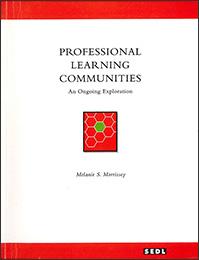What We Are Learning
Throughout our research on professional learning communities, four key themes emerged that will be echoed here: (1) A professional learning community is not a thing; rather, it is a way of operating. (2) Change requires learning, and learning motivates change. (3) When staff work and learn within professional learning communities, continuous improvement becomes an embedded value. (4) Professional learning communities exist when each of the five dimensions are in place and working interdependently together.
Theme 1: A Way of Operating
A critical element in professional learning communities is the continuous engagement of staff in inquiry directed toward improving the learning of students. Such inquiry does not have an endpoint. Instead, it is a state of being, an ongoing process that is sustained over time and changes with the environment and the expectations. All professional members of the school are invested in their own learning and make the changes necessary to become more effective in addressing the needs of all students, helping them to achieve high standards of learning. Although Hord (1997) specified five consistent dimensions of a professional learning community, those were not intended to be a checklist, or a prescription. In the schools that SEDL has studied, all five dimensions were active, interrelated pieces, stable in challenging times, maintained by the school staff, and believed to be vital components of how the school functioned.
Theme 2: The Relationship of Change and Learning
Fullan and Miles (1992) stated: “Change is learning, loaded with uncertainty.” In developing professional learning communities, SEDL has noted that change requires learning, based on the understanding that one cannot make improvement unless one knows how to improve. More simply stated, “You don’t know what you don’t know.” In order for school staff to appreciate and value the changes needed for improving teaching and learning, not only must there be clear reasons for making the changes but also staff must be given a road map of sorts. To value the change, educators must first learn all they need to know about the change.
Coupled with this is the speculation that learning motivates change. At many professional learning community sites, the learning engaged in by school staff motivated them, as individuals and as organizations, to make significant changes in their instructional structures and actions. Once teachers and administrators in professional learning communities begin to learn that there are other ways and means for accomplishing their goals, they initiate the necessary actions for learning and making changes.
Theme 3: An Embedded Value
In a community that supports and nurtures ongoing learning and improvement, where dialogue and decisions maintain a focus on increasing student learning and achievement, school staff value and appreciate their direct involvement in increasing student learning and improving their school. Little (1997) found evidence suggesting that the value of professional learning communities comes from the staff being as deeply teacher-focused as they are student-focused. One cannot assume that schools can transform themselves into productive and successful places of learning for students without first addressing the learning that must occur among teachers. In professional learning communities, teacher development and improvement are acknowledged as a critical component of bringing quality learning experiences to the classroom. Thus, when teachers in professional learning communities are provided the support and development they need for their own learning to improve their classroom practice, significant value is placed on the effect continuous learning has on their work.
Theme 4: Interdependence among the Five Dimensions
A professional learning community exists when each of the five dimensions (Hord, 1997)—supportive and shared leadership, shared visions and values, collective learning and application of learning, supportive conditions, and shared personal practice—are in place and working together. The five dimensions are not discrete, nor does each exist in a vacuum. Rather, they are deeply intertwined, having impact on, and impacting, each other. These interrelationships are noted on the Professional Learning Community Indicators matrix (Figure 2). Examples of the dimensions, and how each plays a part in the development of the others, is noted on the horizontal rows. The ways in which one dimension is impacted or influenced by the other four dimensions can be noted by looking down the vertical columns.
The matrix is a visual depiction, showing how each of the dimensions of a professional learning community is dependent on the others. While there are various “starting points” in developing professional learning communities, the infrastructure itself is not dependent on one individual, one program, or new curriculum. In developing professional learning communities, principals are able to move beyond the role of the traditional principal to one that actively shares leadership, and encourages collective learning among teachers. The teachers within such a structure accept the leadership roles, participate and find value in collective learning and problem solving, and apply those learning experiences to their teaching practice. Just as each dimension is impacted by the other four, teachers and administrators must form a working relationship with the common goal of increasing student learning.
The strength of relationships between administrators and staff, and among staff members, is the underpinning of all five dimensions of professional learning communities. Progress is made when administrators and teachers find ways to go beyond the traditional structures of schools by learning together, and applying research-based teaching practices, working toward the common goal of increasing student learning. Principals and teachers both play major roles in this endeavor.
Next Page: First Steps

